Did you know that over 20% of Tagalog vocabulary has roots in Spanish? This surprising fact highlights the deep connection between the Philippines and its colonial past. For over 300 years, Spanish colonization shaped the archipelago’s culture, traditions, and identity.
The introduction of new customs, religious practices, and linguistic elements during this period left a lasting mark. Today, many Filipino traditions, names, and even festivals reflect this blend of Hispanic and indigenous influences. From the widespread use of Spanish-derived surnames to the vibrant Catholic celebrations, the legacy is undeniable.
This cultural exchange wasn’t one-sided. The Philippines also contributed to the global spread of Hispanic traditions, creating a unique fusion that continues to thrive. Understanding this history helps us appreciate the richness of Filipino heritage and its global significance.
Key Takeaways
- Spanish colonization influenced Filipino culture for over 300 years.
- About 20% of Tagalog vocabulary comes from Spanish.
- Many Filipino traditions and festivals have Hispanic roots.
- Spanish-derived surnames are common in the Philippines.
- The fusion of Hispanic and indigenous elements created a unique cultural identity.
Introduction: Spanish Influence in the Philippines
The Philippines, a vibrant archipelago, bears the enduring imprint of Spain’s colonial legacy. For over three centuries, the country was shaped by Hispanic customs, traditions, and governance. This period introduced profound changes that continue to resonate in modern Filipino society.
One of the most significant impacts was on language. Spanish became the dominant medium for governance, education, and religion. Today, thousands of Spanish loanwords are embedded in Filipino dialects, such as “mesa” (table) and “eskwela” (school). This linguistic fusion reflects the deep integration of Hispanic elements into local traditions.
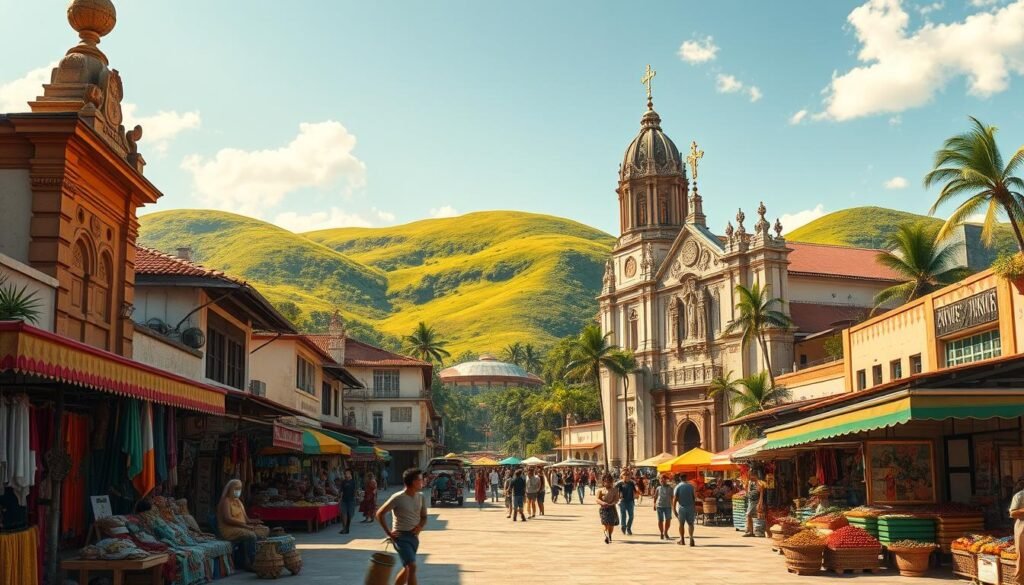
The cultural exchange wasn’t limited to language. Spanish rule brought new religious practices, architectural styles, and societal norms. Catholicism became a cornerstone of Filipino identity, blending seamlessly with indigenous beliefs. Festivals like Sinulog and Pahiyas showcase this unique heritage.
Additionally, the introduction of English during the American era created a bilingual society. This multilingual environment allowed Filipino dialects to evolve alongside Spanish and English influences. The result is a rich cultural tapestry that celebrates both local and foreign roots.
From surnames to culinary traditions, the Spanish legacy is deeply woven into Filipino life. This blend of Hispanic and indigenous elements has shaped a distinct national identity, making the Philippines a fascinating example of cultural fusion.
Historical Background of the Spanish Language
The roots of the Spanish tongue trace back to ancient Roman conquests. Emerging from Vulgar Latin, it evolved into a distinct dialect over centuries. This transformation was shaped by cultural and historical shifts, particularly during the medieval period.
Roman Roots and Medieval Evolution
Roman influence played a pivotal role in the early development of Spanish. The introduction of Latin laid the foundation for vocabulary and grammar. Over time, this evolved into Old Spanish, blending indigenous elements with Roman linguistic traditions.
During the medieval era, the Reconquista period further shaped the language. As Christian kingdoms reclaimed the Iberian Peninsula, Toledo emerged as a cultural hub. Here, a standardized written form of Spanish began to take shape, marking a significant milestone in its history.

The Reconquista and Colonial Expansion
The Reconquista not only unified Spain but also solidified the dominance of Castilian Spanish. This dialect became the basis for the modern language. With the Age of Exploration, Spanish spread globally, reaching the Americas, Asia, and beyond.
Colonial expansion introduced Spanish to new regions, where it blended with local dialects. This cultural exchange enriched the language, creating unique variations. Today, Spanish stands as one of the world’s most widely spoken tongues, a testament to its enduring legacy.
Spanish Language: Its Legacy in Filipino Culture
The linguistic landscape of the Philippines is a testament to centuries of cultural exchange. Over time, foreign influences have woven themselves into the fabric of local dialects, creating a unique blend of sounds and meanings. This evolution reflects the deep connections between the archipelago and its colonial past.
Linguistic Transformations in the Philippine Setting
For over 300 years, foreign vocabulary became part of everyday communication. Words like “mesa” (table) and “eskwela” (school) are now staples in Filipino dialects. This integration wasn’t just about borrowing; it was about adapting these terms to fit local contexts.
The process of linguistic transformation was gradual. It involved not only the adoption of new words but also the blending of grammatical structures. This created a hybrid form of communication that continues to thrive today.
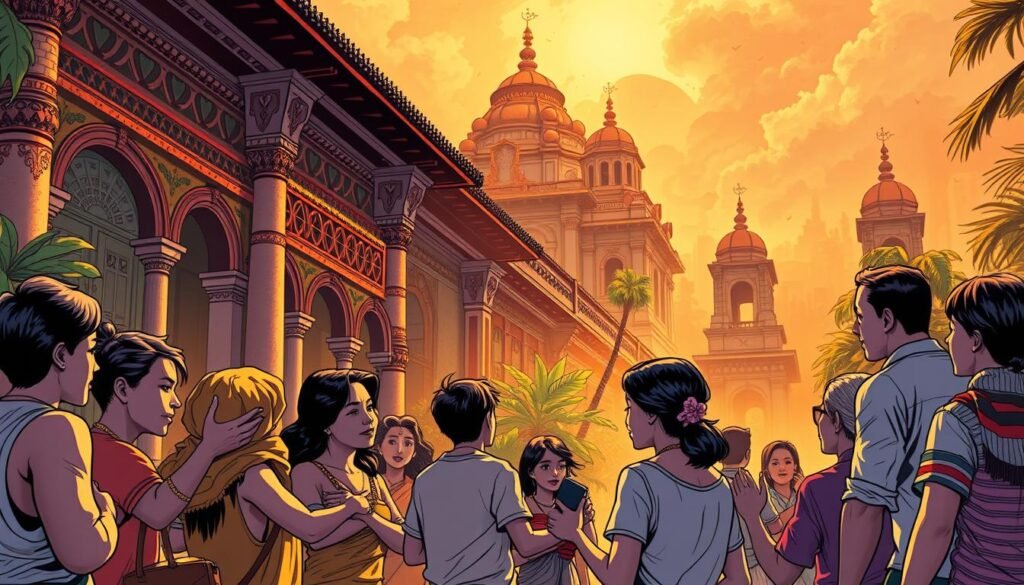
Integration with Local Dialects
Local dialects absorbed foreign vocabulary seamlessly. For example, the Visayan language includes around 6,000 borrowed terms. These words are used in daily conversations, literature, and even religious texts.
Translations played a key role in preserving cultural and religious works. Early texts like the “Doctrina Christiana” were written in both foreign and local scripts. This ensured that important messages reached a wider audience.
“The blending of foreign and indigenous elements has created a linguistic identity that is uniquely Filipino.”
Here are some examples of borrowed words commonly used in Filipino dialects:
| Foreign Word | Filipino Equivalent | Meaning |
|---|---|---|
| Dios | Diyos | God |
| Kalye | Kalsada | Street |
| Pamilya | Pamilya | Family |
These linguistic transformations have contributed to a distinct cultural identity. They remind us of the Philippines’ rich history and its ability to adapt and thrive through change.
Spanish Colonization and Cultural Exchange in the Philippines
The arrival of colonial powers in the Philippines brought profound changes to its cultural and religious landscape. Over three centuries of rule introduced new traditions, societal hierarchies, and practices that remain deeply embedded in modern Filipino life.
Impact on Religion and Traditions
One of the most significant legacies was the establishment of Catholicism. This faith became a cornerstone of Filipino identity, blending with indigenous beliefs to create a unique spiritual tradition. Churches, like the iconic San Agustin Church in Manila, stand as testaments to this enduring influence.

Religious festivals, such as the Sinulog in Cebu and the Pahiyas in Quezon, showcase this blend. These events highlight the fusion of Hispanic and local customs, creating vibrant celebrations that draw crowds from across the south and beyond.
Family customs also evolved during this period. The introduction of Spanish surnames, like Reyes and Santos, reflects the colonial policies that shaped Filipino social structures. These names remain a proud part of Filipino heritage today.
Historical examples of this cultural exchange include the retablo in Catholic churches, which became a central feature of religious architecture. These ornate altarpieces often housed the town’s patron saint, symbolizing the deep connection between faith and community.
The Spanish colonial era not only transformed religion and traditions but also laid the foundation for modern Filipino society. This rich history spanish influence continues to shape the nation’s identity, reminding us of the enduring power of cultural exchange.
Evolution of Filipino Identity Under Spanish Rule
The Filipino identity we know today is a product of centuries of cultural blending under colonial rule. Over three centuries of Spanish influence reshaped the archipelago’s culture, creating a unique hybrid identity that continues to thrive.
Colonial education played a significant role in this transformation. The establishment of Catholic-run schools introduced new subjects like religious studies and philosophy. These institutions became the foundation for modern educational reforms, shaping the intellectual course of Filipino society.
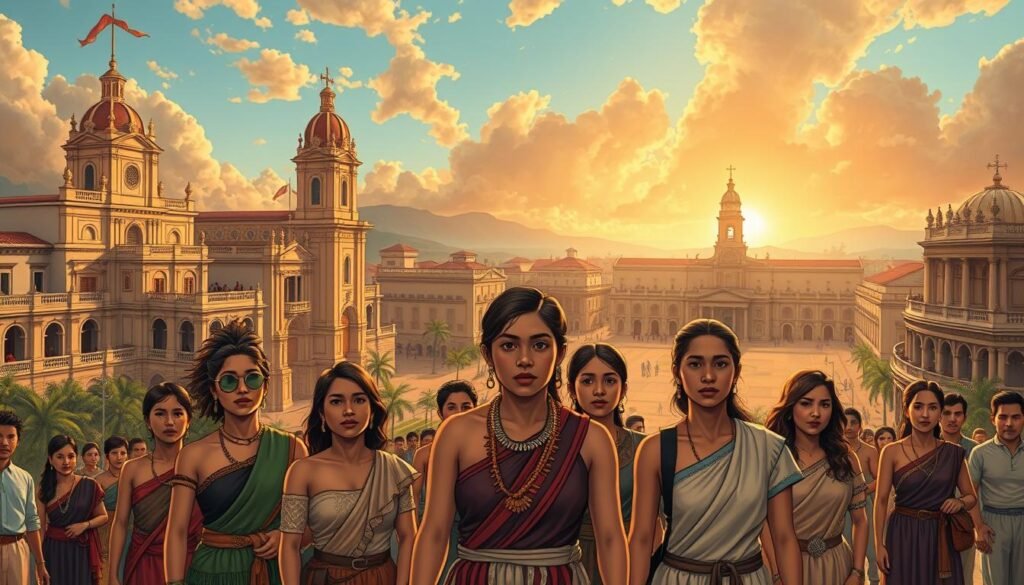
Religion also played a pivotal role in redefining cultural identity. Catholicism became deeply ingrained in Filipino life, blending with indigenous beliefs to create a distinct spiritual tradition. Festivals like Sinulog and Pahiyas are vibrant examples of this fusion.
Hybrid cultural forms emerged during this period, reflecting the amalgamation of indigenous and colonial influences. From architecture to literature, these elements continue to shape modern Filipino society. The form of governance introduced by colonial rulers also left a lasting impact on societal structures.
Institutional structures, such as the establishment of the first university in Asia, further solidified this cultural evolution. These reforms not only educated the populace but also fostered a sense of national identity that persists today.
Here’s a brief overview of key influences during this period:
| Aspect | Influence |
|---|---|
| Education | Introduction of Catholic-run schools and new subjects |
| Religion | Blending of Catholicism with indigenous beliefs |
| Governance | Establishment of colonial administrative systems |
| Culture | Emergence of hybrid traditions and festivals |
Modern Filipino identity still reflects these remnants of colonial influence. From surnames to culinary traditions, the legacy of Spanish rule is deeply woven into the fabric of Filipino life. This rich history reminds us of the enduring power of cultural exchange.
Spanish Influence on Filipino Arts and Literature
The fusion of Hispanic and Filipino creativity has left an indelible mark on the archipelago’s artistic heritage. From poetry to architecture, the Philippines’ creative traditions reflect a deep connection to its colonial past. This influence is particularly evident in the realm of literature, where Spanish classics have inspired generations of local writers.
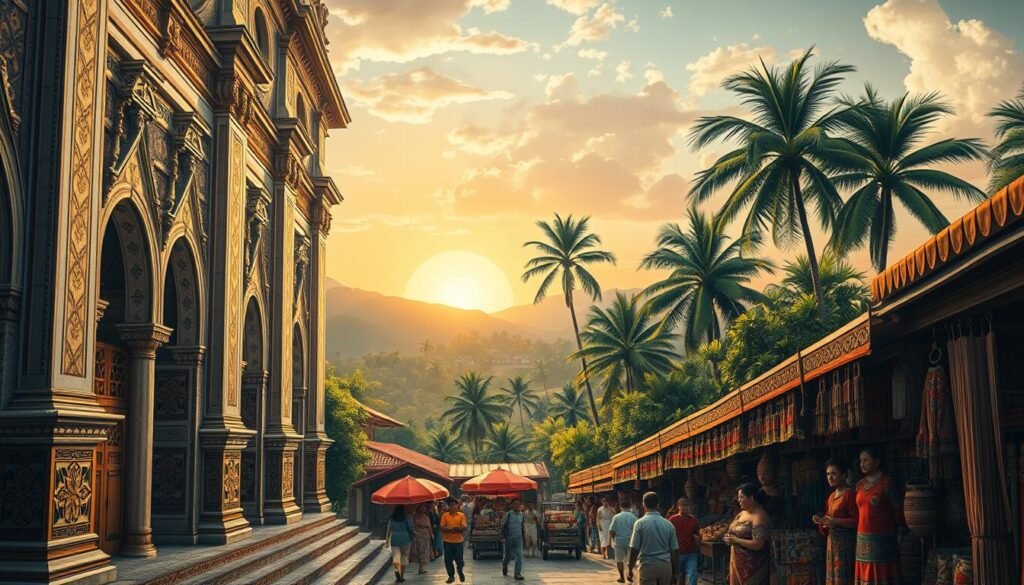
Literary Contributions and Spanish Classics
Spanish literature has deeply influenced Filipino literary traditions. Masterpieces like Don Quixote have been widely read and adapted, shaping the way Filipino writers approach storytelling. The works of a spanish speaker like Jose Rizal resonate with readers, blending local themes with universal narratives.
During the late 19th century, the Propaganda Movement brought a surge of literary activity. Writers like Marcelo H. del Pilar and Graciano Lopez-Jaena used their works to advocate for social reform. Their writings, often published in La Solidaridad, became a cornerstone of Filipino nationalist literature.
“The blending of foreign and indigenous elements has created a literary identity that is uniquely Filipino.”
Translations of Spanish works into Filipino languages have also played a significant role. Early texts like the Doctrina Christiana were written in both Spanish and local scripts, ensuring their accessibility. This practice continues today, with modern adaptations of classic literature enriching the cultural landscape.
Beyond literature, Spanish artistic styles have influenced Philippine visual arts and architecture. Churches like San Agustin Church in Manila showcase intricate designs that blend Hispanic and indigenous elements. These structures stand as testaments to the enduring legacy of Spanish creativity.
The long history of reading Spanish texts has fostered a culture of learning and creative expression in the Philippines. From the establishment of the first universities to the rise of modern literary festivals, this heritage continues to inspire new generations of artists and writers. For more on this topic, explore why Filipino literature remains uniquely diverse.
Spanish Architectural and Urban Legacy in Filipino Cities
The urban landscapes of the Philippines are a living testament to centuries of architectural evolution. Colonial design, particularly from the region of Spain, has left an indelible mark on the country‘s cities. From churches to ancestral homes, these structures reflect a blend of European elegance and local ingenuity.
One of the most iconic features is the Bahay na Bato, a style that evolved from traditional nipa huts. This design incorporates stone foundations and wooden upper floors, showcasing a fusion of indigenous and colonial influences. Churches, like San Agustin in Manila, are prime examples of this architectural blend, with their intricate carvings and sturdy construction.
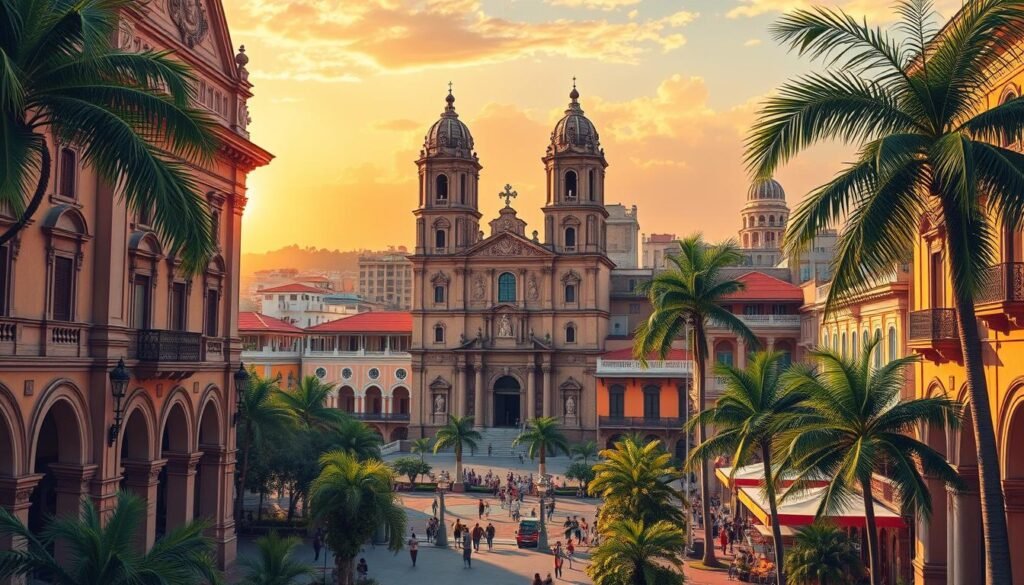
Urban layouts in cities like Vigan and Cebu also reflect colonial planning. Wide plazas, grid-like streets, and central churches were common features. These designs not only served practical purposes but also symbolized the dominance of colonial rule. Today, they remain a vital part of the region‘s cultural heritage.
Preservation efforts are crucial in maintaining these historical landmarks. Organizations and local governments work tirelessly to restore and protect these structures. Their efforts ensure that future generations can appreciate the tangible links to the past.
Here’s a closer look at key architectural elements and their significance:
| Feature | Description | Significance |
|---|---|---|
| Bahay na Bato | Stone houses with wooden upper floors | Blend of local and colonial design |
| Earthquake Baroque | Thick walls, low bell towers | Adaptation to seismic activity |
| Central Plazas | Open spaces surrounded by key buildings | Symbol of colonial governance |
The blend of European and local traditions has created a unique architectural identity. This legacy continues to shape the urban development of the Philippines, reminding us of the enduring power of cultural exchange.
Culinary Influences: Spanish Flavors in Filipino Cuisine
Filipino cuisine is a vibrant blend of flavors, deeply influenced by centuries of cultural exchange. The introduction of new ingredients and cooking techniques during colonial rule has left a lasting mark on traditional recipes. Today, many Filipino dishes reflect this fusion, creating a unique gastronomic identity.
One of the most significant contributions was the introduction of ingredients like olive oil, paprika, and cured sausages. These elements became staples in Filipino kitchens, blending seamlessly with local produce. Dishes like adobo and menudo showcase this harmonious mix of flavors.
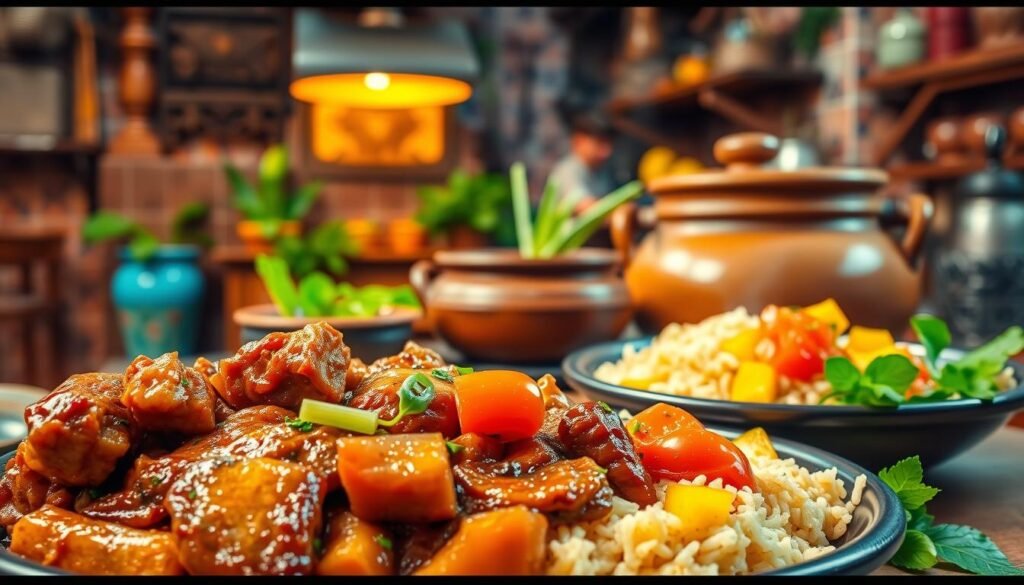
Historical events, such as the Manila-Acapulco Galleon Trade, played a key role in this culinary exchange. Over the years, Filipino cooks adapted foreign recipes to suit local tastes. For example, arroz valenciana evolved into a festive dish often served during special occasions.
Spanish-inspired dishes are not just reserved for holidays. Many have become part of everyday meals, reflecting their deep integration into Filipino culture. From breakfast staples like tocino to hearty stews like afritada, these dishes are enjoyed across the country.
Here’s a look at some popular Spanish-inspired Filipino dishes and their local variations:
| Spanish Dish | Filipino Variation | Key Ingredients |
|---|---|---|
| Paella | Arroz Valenciana | Rice, chicken, chorizo, saffron |
| Embutido | Filipino Embutido | Ground pork, raisins, eggs |
| Guisado | Gisado | Meat, tomatoes, potatoes |
The influence of Spanish cuisine extends beyond recipes. It has shaped Filipino dining habits, such as the practice of serving multiple courses during celebrations. This tradition is particularly evident during fiestas, where food plays a central role.
From the streets of Manila to the provinces, the legacy of Spanish flavors continues to thrive. This culinary fusion is a testament to the Philippines’ ability to adapt and innovate, creating a food culture that is uniquely its own.
Spanish Naming Conventions and Surnames in the Philippines
Family names in the Philippines carry a rich history tied to colonial influences. During the Spanish colonial period, naming customs were systematically introduced, leaving a lasting legacy. Today, many Filipino surnames reflect this historical blend, showcasing a unique variety of cultural and administrative practices.
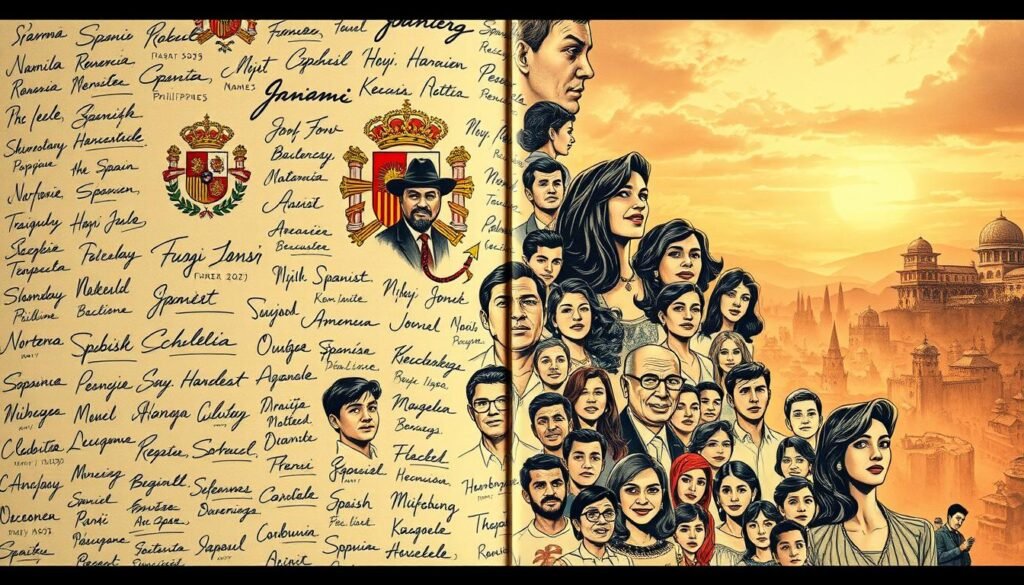
Historical Roots of Filipino Family Names
The adoption of Spanish surnames began in the 16th century, marking a significant shift from indigenous naming practices. Before colonization, Filipinos often used single names or patronymics tied to their firstborn child. The introduction of surnames was part of a broader effort to streamline governance and census records.
In 1849, the Claveria Decree mandated that Filipinos adopt Spanish surnames. This policy aimed to standardize naming practices across the archipelago. As a result, many families received surnames based on a catalog of approved names, often starting with the same letter within a barangay.
Here are some common Filipino surnames of Spanish origin:
- Reyes
- Santos
- Cruz
- Garcia
These names not only reflect colonial influence but also highlight the cultural integration that shaped Filipino identity. The blending of Spanish and indigenous elements created a naming system that is uniquely Filipino.
“The introduction of surnames was more than an administrative act; it was a cultural transformation that reshaped Filipino identity.”
Today, Filipino naming conventions continue to evolve. Many families use both paternal and maternal surnames, with the mother’s name often serving as the middle name. This practice underscores the enduring influence of Spanish customs while adapting to modern contexts.
For more on the evolution of naming practices, explore Spanish naming customs and their global impact.
Spanish Impact on Filipino Education and Language Policy
The educational system in the Philippines has been profoundly shaped by centuries of colonial influence. During the Spanish era, reforms introduced new structures that continue to impact curriculum design and language policy today. The origin of these changes lies in the colonial administration’s efforts to establish a standardized system of learning.
Spanish was introduced as an official language and became a cornerstone of early education. Schools were established to teach not only the language but also the culture and traditions of Spain. These institutions laid the foundation for modern educational practices in the Philippines.
Current language policies still reflect remnants of this colonial influence. The 1987 Constitution, for example, emphasizes the development of Filipino as the national language while recognizing the importance of English. This dual-language approach is a direct result of the historical evolution of language instruction.
Historical records show that the colonial government aimed to integrate Spanish into daily life. However, widespread adoption was limited, leading to a unique linguistic landscape. The history spanish language in the Philippines is a testament to the complex interplay between colonial ambitions and local realities.
“The blending of foreign and indigenous educational practices has created a system that is uniquely Filipino.”
Here are some key aspects of Spanish-based education and its long-term effects:
- Introduction of standardized curricula and teaching methods.
- Establishment of the first universities, such as the University of Santo Tomas.
- Integration of Catholic teachings into the educational framework.
- Modern bilingual policies that balance local and global needs.
The legacy of Spanish educational reforms continues to shape Filipino society. From language policies to institutional structures, the influence is undeniable. For more insights into the evolution of language policy, explore this study on the Philippines’ linguistic landscape.
The Role of Religion in Promoting Spanish Culture in the Philippines
Religion has been a cornerstone of cultural identity in the Philippines, shaping traditions and daily life. During the colonial period, Catholicism became a powerful tool for spreading Spanish cultural values. Missionaries introduced the faith, which quickly took root and blended with indigenous beliefs, creating a unique spiritual pattern.
Religious institutions, such as churches and schools, became centers for cultural and educational exchange. These places not only taught the faith but also introduced Spanish art, music, and language. The Doctrina Christiana, one of the earliest catechism books, was published in both Spanish and local dialects, making it accessible to a wider audience.
Festivals and rituals played a key role in preserving Spanish traditions. Events like the Sinulog in Cebu and the Pahiyas in Quezon showcase the fusion of Hispanic and local customs. These celebrations are vibrant reminders of the colonial past, blending religious devotion with cultural pride.
Worship practices also incorporated Spanish artistic and linguistic elements. Churches, with their intricate designs and altarpieces, became symbols of this cultural integration. The use of Spanish in religious texts and hymns further solidified its influence.
“The blending of faith and culture has created a spiritual identity that is uniquely Filipino.”
Today, these religious influences are reflected in community practices and celebrations. From family gatherings to town fiestas, Catholicism remains a unifying force. For more on how religion shapes Filipino society, explore the role of religion in Filipino.
In the north, traditions like the Panagbenga Festival highlight the enduring legacy of Spanish culture. These events not only honor the past but also celebrate the rich diversity of Filipino heritage. Through religion, the Philippines continues to preserve and adapt its unique cultural identity.
Social and Economic Changes Brought by Spanish Rule
The colonial era reshaped the Philippines’ social and economic fabric in profound ways. Over time, Spanish policies introduced new structures that transformed trade, class systems, and daily life. These changes laid the foundation for modern Filipino society.
One of the most significant shifts was in trade dynamics. The Manila-Acapulco Galleon Trade connected the Philippines to mexico and beyond, bringing goods like silver, spices, and textiles. This network not only boosted the economy but also introduced new cultural influences.
Social hierarchies also underwent a dramatic transformation. The colonial system created a rigid class structure, with Spanish elites at the top and indigenous populations at the bottom. This stratification influenced everything from land ownership to education, shaping the course of Filipino history.
Economic reforms further cemented these changes. The introduction of new crops like tobacco and sugarcane altered agricultural practices. These industries became central to the colonial economy, leaving a legacy that persists today.
Here’s a closer look at key social and economic changes during this period:
| Aspect | Change | Impact |
|---|---|---|
| Trade | Establishment of the Galleon Trade | Boosted economy, introduced global goods |
| Social Structure | Creation of a rigid class system | Shaped land ownership and education |
| Agriculture | Introduction of cash crops | Transformed farming practices |
The lasting impact of these changes is evident in modern Filipino society. From economic practices to social norms, the colonial legacy continues to shape the nation’s identity. Understanding this history helps us appreciate the resilience and adaptability of Filipino culture.
Modern Reflections: Spanish Heritage in Contemporary Filipino Society
Modern Filipino society continues to honor its rich heritage through lively celebrations and artistic expressions. From vibrant festivals to public commemorations, the Philippines showcases a unique blend of indigenous and colonial influences. These events not only preserve traditions but also highlight the enduring impact of its colonial past.
Festivals and Cultural Celebrations
One of the most prominent examples of this cultural fusion is the Sinulog Festival in Cebu. This event, held every January, features colorful parades, traditional dances, and religious processions. It celebrates the Sto. Niño, a symbol of the country’s Catholic faith introduced during colonial times.
Another notable celebration is the Pahiyas Festival in Quezon Province. Known for its vibrant decorations made from agricultural produce, this festival reflects the blend of Spanish and Filipino traditions. Homes are adorned with colorful displays, showcasing the community’s creativity and gratitude.
These festivals are more than just local events; they are a window into the world of Filipino culture. They attract visitors from across the globe, offering a glimpse into the country’s rich history and traditions.
Art and Music: A Living Legacy
Contemporary Filipino art and music also reflect this cultural fusion. Many artists draw inspiration from colonial-era themes, blending them with modern techniques. For instance, the works of Juan Luna, a renowned Filipino painter, continue to inspire new generations of artists.
Music, too, plays a significant role in preserving this heritage. Traditional instruments like the bandurria and guitarra are still used in folk music, creating a unique sound that resonates with audiences worldwide.
The Modern Filipino Identity
The integration of Spanish elements into Filipino culture has enriched its national identity. From surnames to culinary traditions, these influences are deeply woven into everyday life. This blend of traditions creates a unique cultural tapestry that continues to evolve.
For more on how the Filipino language reflects this cultural evolution, explore the dynamic history of Filipino.
| Festival | Location | Key Features |
|---|---|---|
| Sinulog | Cebu | Colorful parades, religious processions |
| Pahiyas | Quezon Province | Agricultural decorations, community displays |
| Ati-Atihan | Aklan | Street dancing, indigenous costumes |
These celebrations and artistic expressions are a testament to the Philippines’ ability to adapt and innovate. They remind us of the enduring power of cultural exchange and its role in shaping a nation’s identity.
Regional Variations: Spanish Influence Across the Philippine Islands
Across the islands, Spanish heritage has shaped traditions in distinct ways. The Philippines’ regional diversity has led to unique expressions of cultural influence. From dialects to festivals, each area reflects a blend of indigenous and colonial elements.
In the Visayas, Spanish influence is evident in festivals like Sinulog. This celebration combines Catholic traditions with local dances and music. The word “Sinulog” itself reflects this fusion, symbolizing the region’s cultural evolution.
In Luzon, particularly in Pampanga, culinary traditions showcase Spanish flavors. Dishes like morcon and embutido highlight the blending of recipes and ingredients. These adaptations demonstrate how regional geography and history shape cultural practices.
Mindanao, on the other hand, presents a more nuanced picture. While Spanish influence is less pronounced, certain areas like Zamboanga retain unique linguistic elements. The Chavacano dialect, for instance, is a creole that blends Spanish with local languages.
Here’s a closer look at regional variations:
| Region | Cultural Practice | Spanish Influence |
|---|---|---|
| Visayas | Sinulog Festival | Religious processions, dances |
| Luzon | Kapampangan Cuisine | Spanish-inspired dishes |
| Mindanao | Chavacano Dialect | Spanish-based creole |
The speaker of Chavacano in Zamboanga illustrates how language evolves in diverse settings. This dialect is a living testament to the region’s historical connections with Spanish culture.
Geography and history play key roles in these variations. Coastal areas, for example, often have stronger Spanish influences due to trade and missionary activities. Inland regions, meanwhile, tend to preserve more indigenous traditions.
For more on how Spanish dialects have shaped global cultures, explore Spanish dialects and varieties.
These regional differences highlight the nuanced nature of Spanish influence in the Philippines. From festivals to dialects, the archipelago’s cultural tapestry is a testament to its rich history and adaptability.
Cross-Cultural Dialogues: Filipino and Spanish Interaction Today
In today’s interconnected world, Filipino and Spanish cultures continue to engage in meaningful dialogues through media, education, and language programs. These interactions highlight the enduring connection between the two cultures, fostering mutual understanding and appreciation.
Media and Popular Culture Impact
Modern media plays a significant role in promoting cultural exchange. Filipino telenovelas and films often incorporate Spanish themes, while Spanish music and television shows gain popularity in the Philippines. This cross-cultural influence enriches both societies, creating a shared global identity.
Social media platforms also serve as bridges, connecting communities across borders. Through these channels, people share traditions, stories, and ideas, ensuring that cultural heritage remains vibrant and relevant.
Ongoing Language Exchange Programs
Language exchange programs are another key form of cultural dialogue. Universities and institutions offer courses that teach both Filipino and Spanish, encouraging students to explore each other’s linguistic heritage. These programs not only improve language skills but also deepen cultural appreciation.
For example, the Instituto Cervantes in Manila provides Spanish language classes, while Filipino language programs are gaining traction in Spain. These initiatives highlight the mutual benefits of learning each other’s languages.
Here are some key benefits of these programs:
- Enhanced language proficiency in both english and Spanish.
- Greater understanding of cultural nuances and traditions.
- Opportunities for academic and professional growth.
Collaborative projects, such as joint research and cultural festivals, further strengthen these ties. These efforts ensure that the legacy of Filipino-Spanish interaction continues to thrive in the modern era. For more insights into this cultural evolution, explore the historical vocabulary insights.
Conclusion
The Philippines’ cultural identity is a vibrant blend of traditions shaped by centuries of influence. From art and architecture to social structures, the legacy of colonial history remains deeply embedded in everyday life. This unique fusion has created a dynamic heritage that continues to evolve.
Preserving this cross-cultural dialogue is essential for future generations. Studying these influences helps us understand the roots of Filipino identity and its global significance. It also highlights the importance of adapting traditions while honoring the past.
Today, this heritage is celebrated in festivals, literature, and even culinary practices. For example, the Sinulog Festival in Cebu showcases the blending of indigenous and colonial elements. Such events remind us of the enduring power of cultural exchange.
As we look to the future, fostering this connection ensures that the Philippines remains a person of interest in global cultural studies. For more insights into how these influences shape modern society, explore this study on cultural evolution.
FAQ
How did Spanish colonization shape Filipino culture?
Spanish rule introduced significant changes in religion, traditions, and social structures, leaving a lasting impact on Filipino identity and customs.
What are some examples of Spanish influence in Filipino cuisine?
Dishes like adobo, lechon, and ensaymada reflect the blending of Spanish flavors with local ingredients, creating a unique culinary tradition.
How did Spanish architecture affect Filipino cities?
Colonial-era churches, plazas, and ancestral homes showcase Spanish design, which remains a prominent feature in many urban areas.
What role did religion play in spreading Spanish culture in the Philippines?
Catholicism became deeply rooted in Filipino society, influencing festivals, education, and daily life during and after the colonial period.
How did Spanish naming conventions influence Filipino surnames?
Many Filipino family names, such as Santos, Cruz, and Reyes, originated from Spanish traditions imposed during colonization.
What are some modern reflections of Spanish heritage in the Philippines?
Festivals like Sinulog and Pahiyas, as well as the continued use of Spanish loanwords, highlight the enduring legacy of Spanish culture.
How did Spanish colonization impact Filipino arts and literature?
Spanish classics and religious texts inspired local writers, leading to the development of a rich literary tradition that blends native and foreign influences.
Are there regional differences in Spanish influence across the Philippines?
Yes, regions like Cebu and Manila show stronger Spanish cultural imprints, while others retain more indigenous traditions.
How does Spanish heritage continue to influence Filipino education today?
Spanish loanwords and historical studies remain part of the curriculum, preserving the language’s role in shaping Filipino identity.
What are some examples of cross-cultural dialogues between the Philippines and Spain today?
Language exchange programs and media collaborations foster ongoing cultural and linguistic connections between the two nations.
Source Links
- The Impact of Spanish Colonization on Filipino Culture – Pinas Culture
- The Influence of Spanish on Filipino Language – Fluent Filipino
- Spanish language in the Philippines
- Spanish in the Philippines: Language, Heritage, and Modern Influence
- The History of the Spanish Language | Lingvist
- Spanish Language: History, structure, basics, and facts
- Spanish influence on Filipino culture
- Spanish Colonial Influences on Filipino Culture
- The ebb and flow of Spanish influence on Filipino culture – Decolonising Modern Languages and Cultures
- The Spanish Colonial Tradition in Philippine Visual Arts – National Commission for Culture and the Arts
- Translating Cultures: A Bridge Between Tagalog and Spanish Tongues
- The Spanish Influence on Filipino Culture and Language
- Tagalog’s Timeline: From Ancient Script to National Status
- Philippine Literature in Spanish – National Commission for Culture and the Arts
- Philhispanic classics. Instituto Cervantes of Manila
- Spain remains: The major Spanish influences in the Philippines – Manila Standard
- Spanish Colonial architecture
- Spanish Influences in Filipino Culture: A Legacy
- How Traders, Travelers and Colonization Shaped Filipino Cuisine
- The Original Fusion Food: Filipino Food Culture
- Filipino name
- Philippines Naming Customs
- Philippines – Spanish Colonization, Culture, Trade | Britannica
- A History of the Philippines’ official languages
- Education, language policy and language use in the Philippines
- Catholicism in the Philippines during the Spanish Colonial Period 1521-1898 | 4 Corners of the World
- Promoting Spanish Language in the Philippines: Politics, Representations, and Discourses
- Digital History
- Impact of Spanish Colonization (U.S. National Park Service)
- Spanish colonization of the Americas
- Working with Spanish Colonial Records and Archives: Reflections and Practicalities – Kyoto Review of Southeast Asia
- Colonial Legacies: Spanish, American, and Japanese Influences on Filipino Culture and the Modern Employee
- Reflections on the Spanish Conquest and its Representation in the Philippines: El Pacto de Sangre (1886, The Blood Compact) by Juan Luna (1857-1899)
- Variation in Spanish /s/: Overview and New Perspectives
- The representation of Spanish in the Philippine Islands (Chapter 25) – A Political History of Spanish
- The Filipino Language: A Comprehensive Overview
- | The Columbia Journal of Asia
- Answers to: a written conclusion for the influence of Spanish to the language and lives of filipinos
- Executive Summary and Conclusions of the Elcano Report “Towards the strategic renewal of Spain’s foreign policy” – Elcano Royal Institute

